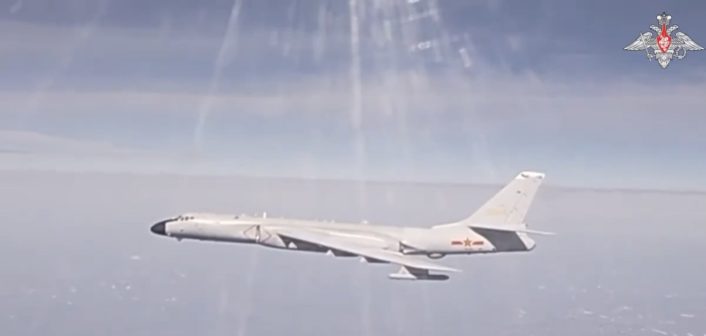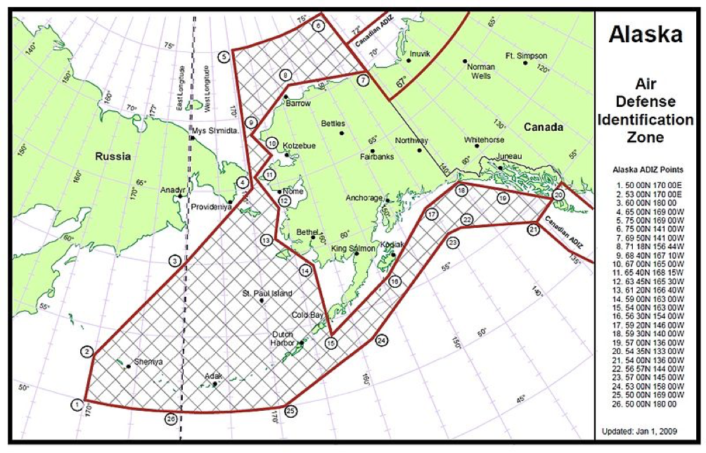At least six NORAD fighters, including F-35, F-16 and CF-188 jets, intercepted Russian and Chinese bombers inside the Alaska ADIZ (Air Defense Identification Zone).
On July 24, 2024, NORAD (North American Aerospace Defense Command) detected, tracked, and intercepted two Russian Tu-95 and two Chinese H-6 aircraft operating within the Alaska Air Defense Identification Zone (ADIZ). The intercept was conducted by NORAD fighter jets from both the United States and Canada.
According to the Russian MOD, the Russian and Chinese bombers were involved in a joint air patrol lasting more than 5 hours:
“An air group consisting of Tu-95ms strategic missile carriers of the Russian Aerospace Forces and H-6K strategic bombers of the PLA Air Force carried out air patrols over the waters of the Chukchi, Bering Seas and the North Pacific Ocean,” a news release says.
“During the flight, Russian and Chinese crews worked out issues of interaction at all stages of air patrol in the new area of joint operations. Fighter air cover was provided by Su-30SM and Su-35S aircraft of the Russian Aerospace Forces.”

The mission of the Russian and Chinese bombers comes as the U.S. and allied forces are involved in RIMPAC 2024, a large exercise in the Pacific region near Hawaii, that this year sees the involvement of 29 nations, 40 surface ships, three submarines, 14 national land forces, over 150 aircraft, and 25,000 personnel.
Several interceptors
“At certain stages of the route, the air group was accompanied by fighters from foreign countries.”
In fact, footage filmed from aboard a Russian Tu-95 Bear show that at a certain point during their trip in international airspace within the Alaska ADIZ, the bomber was escorted by two F-16s of the 18th FIS (Fighter Interceptor Squadron), including one sporting the aggressor paint scheme; two U.S. F-35A stealth jets and two RCAF (Royal Canadian Air Force) CF-188 Hornets.
It is unclear whether all three pairs of fighters were scrambled to carry out a Visual Identification (VID) of the Russian and Chinese aircraft. Considering that at least one of the Canadian Hornets does not appear to be carrying any Air-to-Air Missiles (AAMs), it is possible that the two CF-188s were already airborne for a training mission and were then diverted to shadow the Tu-95s and H-6s.
For sure, the number of NORAD fighters visible in the clip released by the Russian MOD is unusual, if compared to other similar “close encounters” in the same area.
“During the execution of their missions, aircraft from both countries operated strictly in accordance with the provisions of international law. There were no violations of the airspace of foreign states,” the Ministry said. “Upon completion of the joint air patrol, all involved aircraft returned to their home airfields. The event was held as part of the implementation of the military cooperation plan for 2024 and is not directed against third countries.”
China and Russia conduct joint air strategic patrol over Bering Sea on July 25. This marks the eighth air strategic patrol organized by the two militaries since 2019.
Photos from China PLA Air Force Weibo accounthttps://t.co/g9w27FRnnM pic.twitter.com/oeZA4cUQR9
— Ryan Chan 陳家翹 (@ryankakiuchan) July 25, 2024
According to NORAD, the Russian and PRC aircraft stayed within international airspace and did not breach American or Canadian sovereign airspace. “This Russian and PRC activity in the Alaska ADIZ is not seen as a threat, and NORAD will continue to monitor competitor activity near North America and meet presence with presence.”
NORAD is a unique bi-national command between the United States and Canada. It utilizes a layered defense network composed of satellites, ground-based and airborne radars, and fighter aircraft, all operating seamlessly together to detect, track, and determine appropriate actions for aircraft. NORAD remains prepared to deploy various response options in defense of North America.
An ADIZ is a designated area of international airspace, extending beyond sovereign airspace, where the identification of all aircraft is required for national security purposes.
Air Defense Identification Zone
As explained in other articles, here at The Aviationist, there’s a significant difference between territorial sky and ADIZ.
The Air Defense Identification Zone (ADIZ) is a designated airspace surrounding a nation or part of it where strict identification, tracking, and control of aircraft are enforced for national security reasons. Aircraft flying within these zones without proper authorization may be intercepted by fighter aircraft on Quick Reaction Alert (QRA). ADIZ boundaries often extend beyond national airspace covering territorial waters, and while not defined by international law, any civil aircraft entering these zones is closely monitored and required to provide flight details for identification. Military aircraft not intending to enter national airspace are generally exempt from ADIZ procedures, but foreign military planes within ADIZ may be intercepted, identified, and escorted.


